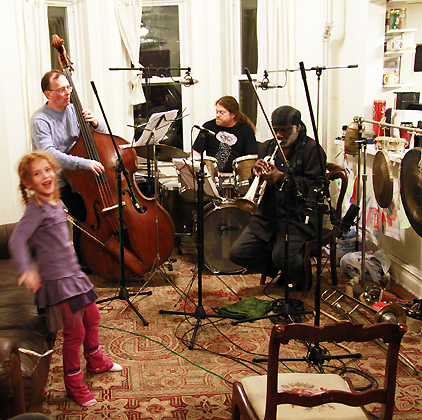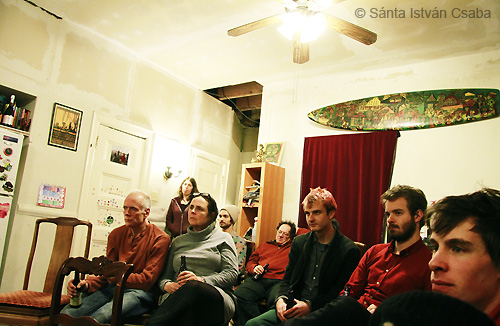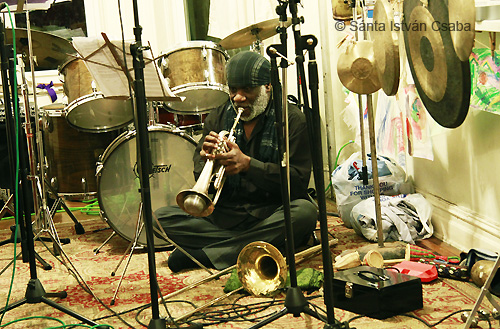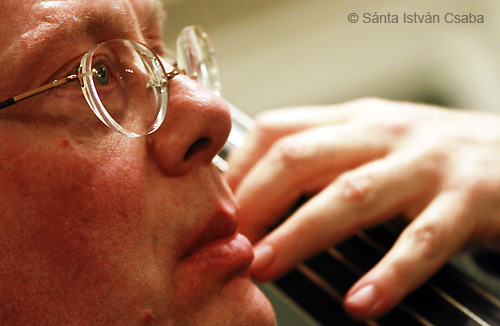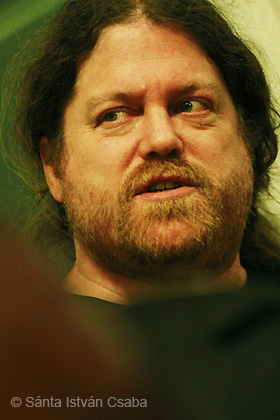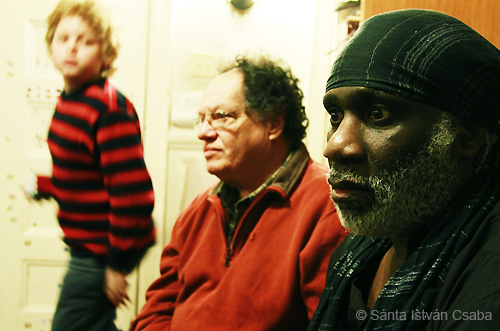Jazz is local and homey, as well as grand and global — that’s what a house concert last weekend in Brooklyn shouted out.
Transylvanian photographer Sánta István Csaba joined me at a “rare NYC performance” of 10³²K, the trio of trombonist Ku-umba Frank Lacy, bassist Kevin Ray and drummer Andrew Drury, at Drury’s apartment in Leffert Gardens. As his images show, the musicians were no less serious about their creative interaction for being in a living room decorated with childrens’ drawings, and the audience was as attentive as any at a well-known club, though they were only asked for a voluntary donation, and were invited to partake of chicken soup and/or bring our own beer.
10³²K — named for the Planck temperature of “absolute hot” theorized to be the condition of the universe just prior to the Big Bang —  is a serious and gratifying ensemble which has performed at Lincoln Center’s David Rubin Atrium and WinterJazz Fest, and recently got a 3.5 star review for its debut ep That Which Is Planted — Live in Buffalo and Rochester. On a cold Friday night about a dozen strangers gathered to hear the trio’s professionally presented two sets with intermission. Repertoire began with a piece by reedist Henry Threadgill, and then seldom-revived repertoire by drummer Steve McCall and bassist Fred Hopkins, Threadgill’s colleagues (both now deceased) in the highly esteemed 1970s-’80s trio Air.
Like Air, 10³²K conceptualizes its music-making as being the product of an equilateral triangle, so that the three members interact as full-time soloists rather than two being accompanists to a frontman. Lacy, who plays flugelhorn as well as trombone and when not blowing added percussive touches with a tambourine and a cymbal, is a sonic powerhouse, with a commanding tone, sensibility of selectivity regarding note choices and shapeliness of phrases. He’s been a strong voice in the Mingus Big Band — which comprises several rambunctious soloists devoted to large-scale works — among other ensembles. Here he had no reason to make an effort to stand out, choosing instead to listen intently to Ray and Drury, the better to forge the group sound.
Kevin Ray is a fluid bassist, able to move quickly on his instrument without losing sound quality, guiding the flow at several tempii. His abilities came in handy when the trio raced through the knotty melody of “Monk’s Dream” and laid down Coltrane’s anthemic theme “Expression,” from his final recording.
Andrew Drury’s style — loose and congenial but emphatic, structurally supportive but continuously improvising — provided the perfect third part. Each piece the band played, including as a finale Albert Ayler’s rousing “Ghosts,” had a narrative arc
that allowed even uninformed members of the crowd to hop aboard the tunes and stay with them as the band expanded its forays into fresh ground.
Once upon a time people made music in their homes as a matter of course — entertainment options were just so limited that doing it yourself was the only way to go. It’s unlikely that jazz featuring the level of virtuosity Lacy, Ray and Drury demonstrate would ever have come into being simply as a folk music, without  ambitions to reach full creative flower, and it wasn’t so long ago that players of high calibre endowed with an exploratory impulse came to understand that if they wanted to be heard by anyone but themselves, they likely had to produce the showcases on their own. That realization was acted on by bands such as Air,  nurtured by Chicago’s AACM (Association for the Advancement of Creative Musicians), as well as the free-thinkers who established NYC’s loft jazz scene and even Charles Mingus, who came up through nightclubs but eventually strove to control his own recording career and stage events like the Newport Rebels shows he produced in 1960 as a rear-garde action complementing George Wein’s  big official to-do.
Last Friday 10³²K had a choice: Rehearse their music and presentation format or perform for people eager enough to hear them that we ventured out to a residential neighborhood and joined the artists in typically private space. My ex- used to say a performance was worth 10 rehearsals, and I bet Lacy, Ray and Drury think that, too. They’re not the only ones opening doors to their apartments in efforts to have their music heard — Brooklyn resident singer Perez has just announced a schedule of 11 “Duo House Concerts” mid-afternoon on Sundays starting Feb. 16 with singer and saxophonist Amy Cervini, who will preview her about-to-be-released cd Jazz Country. Perez’s place is near my own, so attendance is easy (and if you want to attend, rsvp to Perezjazzmusic@hotmail.com). Also, Drury has planned further “Soup and Sound House” events, for his band Content Provider featuring saxophonists Briggan Krauss and Ingrid Laubrock and guitarist Brandon Seabrook on March 1, and Katt Hernandez’ Schematics quartet from Stockholm March 15 (opening act: Ras Moshe/Shayna Dulberger Duo). Lefferts Ave. is just a couple subway stops away, or a doable bike ride, and I can imagine going back for more.

